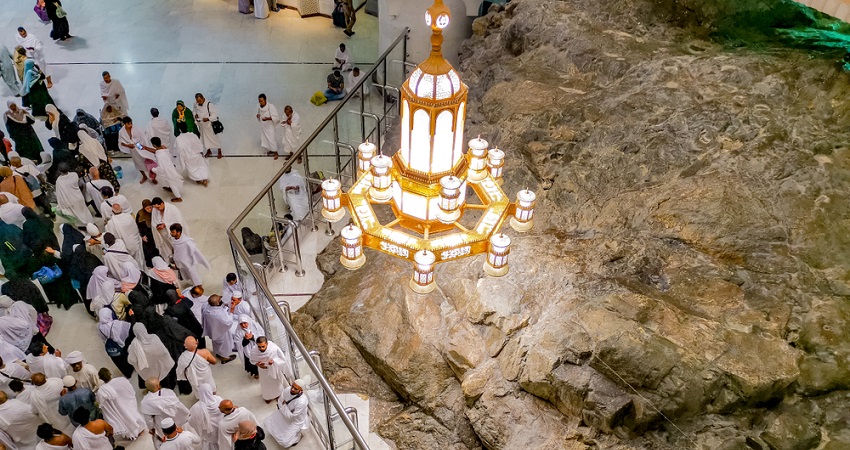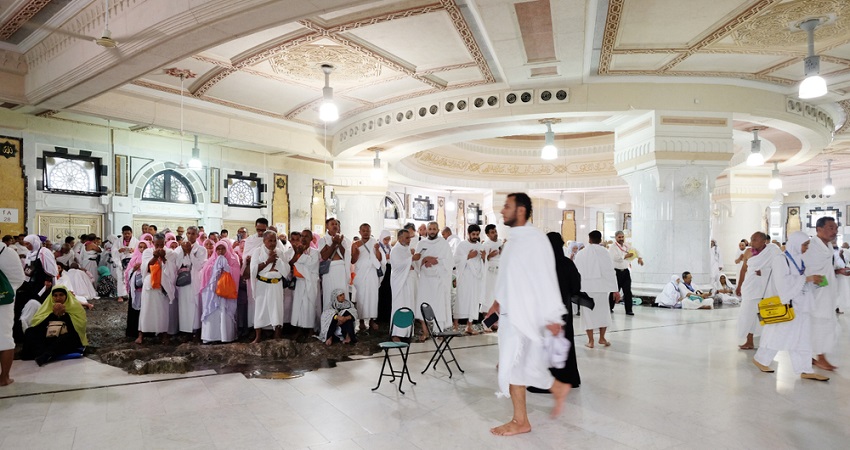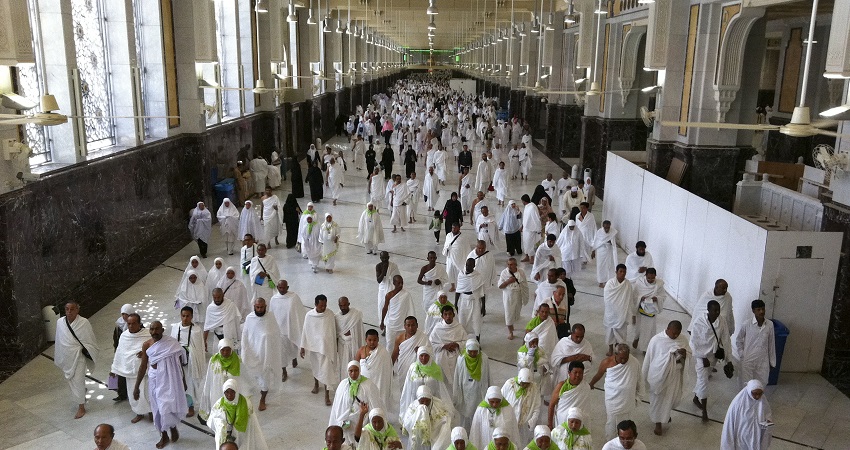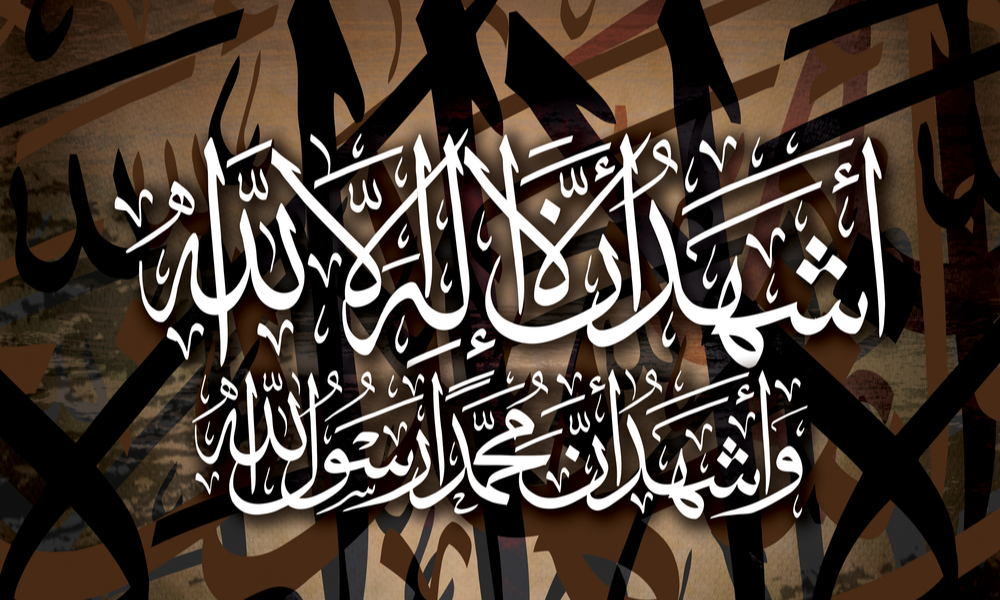Located adjacent to the holy Kaaba in Masjid al-Haram in the divine city of Makkah, Safa and Marwa are two small historical hills that are connected with the bigger mountains, Abu Qubays and Qaiqan. Located in a long gallery that is a part of Al-Masjid Al-Ḥaram, these small hills hold great importance in the Islamic culture.
During the Hajj and Umrah pilgrimages, pilgrims are required to travel back and forth seven times between both Safa and Marwa. This integral ritual is known as Sa’I and serves to honour the mother of great prophet Ismail and her struggle to quench the thirst of her infant child.
The (Hi)Story of Safa and Marwa
In Islamic tradition, the memories of Safa and Marwa are associated with the search for water by Ibrahim’s wife Hajar for their son Ismail. As per popular beliefs, when Ibrahim reached Makkah with his wife Hajar and their baby child Ismail, he was directed by God to leave both of them alone in the desert between these small hills. Initially, Hajar was quite reluctant to stay alone in the desert, but when she learnt that it was God’s command, she put her trust in Allah and agreed to stay alone. Before leaving both of them in the desert with some provisions, including the water skin and some dates, Ibrahim recited the following supplication:
رَّبَّنَا إِنِّي أَسْكَنتُ مِن ذُرِّيَّتِي بِوَادٍ غَيْرِ ذِي زَرْعٍ عِندَ بَيْتِكَ الْمُحَرَّمِ رَبَّنَا لِيُقِيمُوا الصَّلَاةَ فَاجْعَلْ أَفْئِدَةً مِّنَ النَّاسِ تَهْوِي إِلَيْهِمْ وَارْزُقْهُم مِّنَ الثَّمَرَاتِ لَعَلَّهُمْ يَشْكُرُونَ
“Our Lord, I have settled some of my descendants in an uncultivated valley near your sacred House, our Lord, that they may establish prayer. So make hearts among the people incline toward them and provide for them from the fruits that they might be grateful.” [Surah Ibrahim, 14:37]
Soon, their provisions were exhausted and Hajar, who was still breastfeeding Ismail, was unable to produce milk. Consequently, Ismail started feeling thirsty. Seeing this, his mother desperately started searching for water in the area so that she could feed her child. In this desperation to find water, she first climbed the closest hill Safa to have a look of the surrounding region. When she did not see anything, she ran towards Marwa to look around in order to find someone or some source of water. This is how she ran back and forth between both the hills for a total of seven times in the scorching heat before returning to her son, whom she had left on the ground to make her search faster and easier.
When she couldn’t find anything, panic-stricken and worried, Hajar pleaded to Allah to save her son’s life. As per the Islamic tradition, this is when Allah answered her prayers and sent Angel Jibril (Gabriel) to their rescue, who hit the ground with his wing and the water emerged. Hajar drank the holy water and then nursed her son, thereby saving his life. She also dug a well around the water source, which is known as the ZamZam Well. The angel also gave assurance to Hajar that someday, her son and husband will build the house of Allah at the same location.
Since that day, every pilgrim visiting Makkah for Umrah or Hajj has to complete the ritual of taking seven rounds back and forth between Safa and Marwa hills.
Significance of Safa and Marwa
The act of running between these two hills is one of the main rituals of Hajj and Umrah pilgrimages, which makes both Safa and Marwa very much significant. The Islamic culture prescribes running between these two hills because the same act was done by Prophet Muhammad and his companions. As per popular beliefs, the Prophet also performed Sa’i during his farewell Hajj. In the Hadith in Bukhari, Prophet Muhammad said, <em<“If she (Hajar) had left the water, (flow naturally without her intervention), it would have been flowing on the surface of the earth.”
The Safa and Marwa story is a clear depiction of Hajar’s commitment to her son in such harsh circumstances and her unwavering devotion and faith in Allah. Pilgrims going to Hajj or Umrah remember this story and run forth and back between Safa and Marwa to commemorate Hajar’s love for her son and belief in Allah.
Safa and Marwa in the Quran
إِنَّ الصَّفَا وَالْمَرْوَةَ مِن شَعَائِرِ اللَّهِ ۖ فَمَنْ حَجَّ الْبَيْتَ أَوِ اعْتَمَرَ فَلَا جُنَاحَ عَلَيْهِ أَن يَطَّوَّفَ بِهِمَا ۚ وَمَن تَطَوَّعَ خَيْرًا فَإِنَّ اللَّهَ شَاكِرٌ عَلِيمٌ
“Indeed, Safa and Marwa are among the symbols of Allah. So whoever makes Hajj to the House or performs Umrah – there is no blame upon him for walking between them. And whoever volunteers good – then indeed, Allah is appreciative and Knowing.” [Surah al-Baqarah, 2:158]
One can also find mention of Safa and Marwa in the holy Quran, which shows their significance amongst Muslims. It is mentioned in the holy book Quran that both the hills are among the symbols of Allah and that it is obligatory to walk between them, as included in the rites ordained by Allah during the Hajj pilgrimage for Prophet Ibrahim.
Suggested Read: 9 Scientific Facts In The Quran That Will Surprise You
Safa And Marwa Story FAQs
Where are Safa and Marwa located?
Located adjacent to the holy Kaaba in Masjid al-Haram in the divine city of Makkah, Safa and Marwa are two small historical hills that are connected with the bigger mountains, Abu Qubays and Qaiqan. Located in a long gallery that is a part of Al-Masjid Al-Ḥaram, these small hills hold great importance in the Islamic culture.
What is the significance of Safa and Marwa?
The act of running between these two hills is one of the main rituals of Hajj and Umrah pilgrimages, which makes both Safa and Marwa very much significant. The Islamic culture prescribes running between these two hills because the same act was done by Prophet Muhammad and his companions.
Where are Safa and Marwa mentioned in the holy Quran?
One can find mention of Safa and Marwa in the holy Quran, which shows their significance amongst Muslims. It is mentioned in the holy book Quran that both the hills are among the symbols of Allah and that it is obligatory to walk between them, as included in the rites ordained by Allah during the Hajj pilgrimage for Prophet Ibrahim.
How many times shall the pilgrims go back and forth between Safa and Marwa?
During the Hajj and Umrah pilgrimages, pilgrims are required to travel back and forth seven times between both Safa and Marwa.
Are there any nearby attractions or points of interest related to Safa and Marwa?
Safa and Marwa are located within the Masjid al-Haram (the Grand Mosque) in Makkah, which is the holiest site in Islam. While Safa and Marwa themselves hold profound significance as the locations of the Sai ritual, the Grand Mosque itself is a vast and awe-inspiring complex with numerous points of interest. Pilgrims and visitors often explore the mosque beautiful architecture, the Kaaba, the Black Stone, and the Zamzam well, all of which are deeply intertwined with the Hajj and Umrah experience.
How busy are Safa and Marwa during Hajj and Umrah seasons?
During the Hajj and Umrah seasons, Safa and Marwa can become extremely crowded, as pilgrims from around the world perform the Sai ritual. These seasons see a significant influx of worshippers, and queues to complete the Sai can be lengthy. It is advisable to plan your visit during less busy times or exercise patience and adherence to the established rituals when visiting during peak seasons.
Are there any specific dress code or etiquette rules for Safa and Marwa?
While there are no specific dress codes unique to Safa and Marwa, visitors to the Grand Mosque in Mecca are generally expected to adhere to modest and respectful attire. This typically includes wearing clothing that covers the shoulders and knees for both men and women. Additionally, it is customary to remove shoes before entering the mosque premises. When performing the Sai ritual between Safa and Marwa, pilgrims should maintain a sense of devotion, recite supplications, and adhere to the prescribed steps of the ritual.











